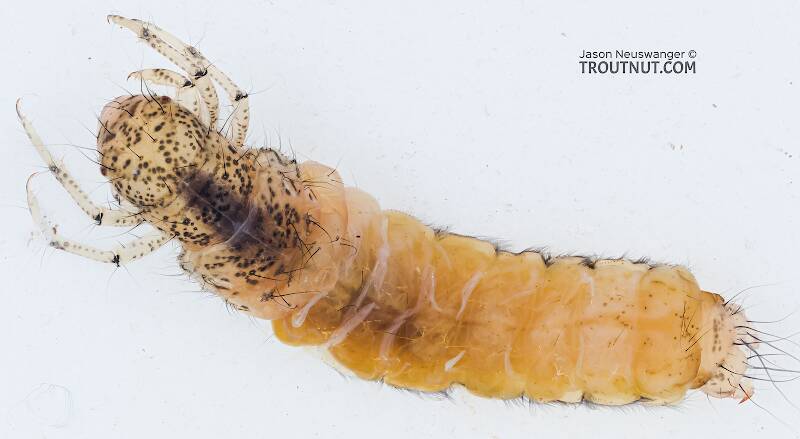
Blue-winged Olives
Baetis
Tiny Baetis mayflies are perhaps the most commonly encountered and imitated by anglers on all American trout streams due to their great abundance, widespread distribution, and trout-friendly emergence habits.
Featured on the forum

This is a striking caddis larva with an interesting color pattern on the head. Here are some characteristics I was able to see under the microscope, but could not easily expose for a picture:
- The prosternal horn is present.
- The mandible is clearly toothed, not formed into a uniform scraper blade.
- The seems to be only 2 major setae on the ventral edge of the hind femur.
- Chloride epithelia seem to be absent from the dorsal side of any abdominal segments.
Based on these characteristics and the ones more easily visible from the pictures, this seems to be Grammotaulius. The key's description of the case is spot-on: "Case cylindrical, made of longitudinally arranged sedge or similar leaves," as is the description of the markings on the head, "Dorsum of head light brownish yellow with numerous discrete, small, dark spots." The spot pattern on the head is a very good match to figure 19.312 of Merritt R.W., Cummins, K.W., and Berg, M.B. (2019). The species ID is based on Grammotaulius betteni being the only species of this genus known in Washington state.
- The prosternal horn is present.
- The mandible is clearly toothed, not formed into a uniform scraper blade.
- The seems to be only 2 major setae on the ventral edge of the hind femur.
- Chloride epithelia seem to be absent from the dorsal side of any abdominal segments.
Based on these characteristics and the ones more easily visible from the pictures, this seems to be Grammotaulius. The key's description of the case is spot-on: "Case cylindrical, made of longitudinally arranged sedge or similar leaves," as is the description of the markings on the head, "Dorsum of head light brownish yellow with numerous discrete, small, dark spots." The spot pattern on the head is a very good match to figure 19.312 of Merritt R.W., Cummins, K.W., and Berg, M.B. (2019). The species ID is based on Grammotaulius betteni being the only species of this genus known in Washington state.

Troutnut is a project started in 2003 by salmonid ecologist Jason "Troutnut" Neuswanger to help anglers and
fly tyers unabashedly embrace the entomological side of the sport. Learn more about Troutnut or
support the project for an enhanced experience here.
Identification: Key to Species of Caudatella Nymphs, Couplet 4
Identification: Key to Species of Caudatella Nymphs, Couplet 4
Adapted from Jacobus 2010 (2010)
| Option 1 | Option 2 |
|---|---|
| Cerci approximately one-third length of median filament (about the length of the abdomen) | Cerci approximately one-sixth length of median filament (about half the length of the abdomen) |
| Distinct pair of medial spines present only on abdominal terga 2–9, with the spine tips blunt | Distinct pair of medial spines present on abdominal terga 1–9, with the spine tips sharp |
| Caudatella heterocaudata | Caudatella columbiella |
Adapted from Jacobus 2010 (2010)
The current couplet is highlighted with darker colors and a icon, and couplets leading to this point have a icon.
Leads to Caudatella edmundsi:
- Maxillary palp vestigial; tarsal claw with two prominent rows of denticles
Leads to Couplet 2:
- Maxillary palp with three distinct segments; tarsal claw with only one distinct row of denticles
Couplet 2
Leads to Caudatella hystrix:
- Paired medial spines on abdominal terga long and curved (at least on middle segments), some almost hook like
Leads to Couplet 3:
- Paired medial spines on abdominal terga relatively straight, none longer than respective segment
Couplet 3
Leads to Caudatella jacobi:
- Cerci approximately two thirds length of median filament
- Abdominal sterna with solid color, never with longitudinal stripes or other such markings
Leads to Couplet 4:
- Cerci less than one-half length of median filament
- Abdominal sterna almost always with three dark, longitudinal markings
Couplet 4
Couplet 4 (You are here)
Leads to Caudatella heterocaudata:
- Cerci approximately one-third length of median filament (about the length of the abdomen)
- Distinct pair of medial spines present only on abdominal terga 2–9, with the spine tips blunt
Leads to Caudatella columbiella:
- Cerci approximately one-sixth length of median filament (about half the length of the abdomen)
- Distinct pair of medial spines present on abdominal terga 1–9, with the spine tips sharp
Start a Discussion of this Couplet
References
- Jacobus, Luke M. 2010. Taxonomic Review of the Caudatella heterocaudata (McDunnough) and C. hystrix (Traver) Complexes (Insecta: Ephemeroptera: Ephemerellidae). Psyche: A Journal of Entomology 2010: 1-5.
- Merritt R.W., Cummins, K.W., and Berg, M.B. 2019. An Introduction to the Aquatic Insects of North America (Fifth Edition). Kendall/Hunt Publishing Company.

